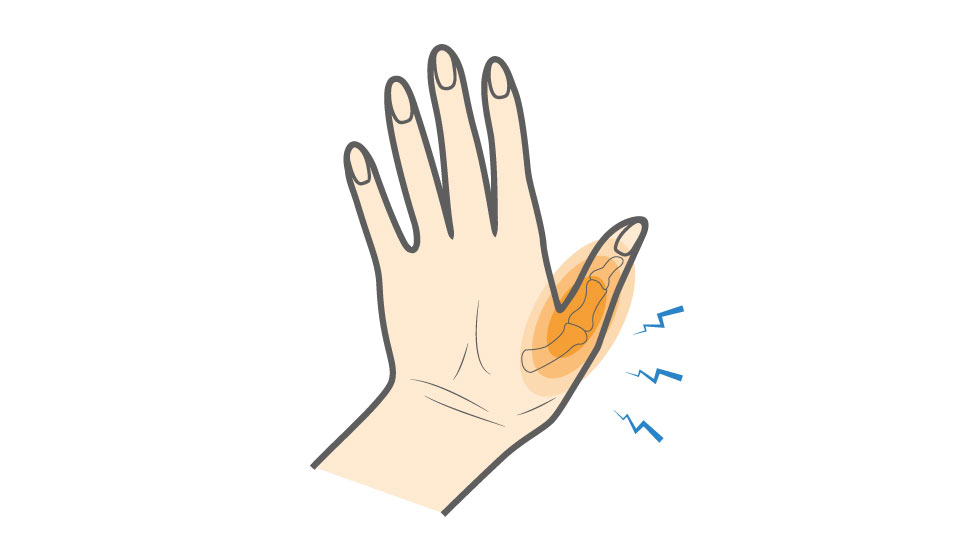A sprained thumb is a type of hand trauma in athletes. The thumb is made up of two bones called phalanges. The thumb bones are connected by bands of flexible tissue called ligaments. A thumb ligament tear or stretch of one of the thumb’s ligaments. A common injury to the thumb is a tear of one of the ligaments called the ulnar collateral ligament, but other ligaments may also be injured. While some thumb sprains heal quickly, a UCL injury of the thumb may be more serious and require surgical treatment.
Thumb Sprain Causes, Symptoms & Treatment Options
A sprained thumb is a common thumb joint injury in athletes. The thumb is made up of two bones called phalanges. The thumb bones are connected by bands of flexible tissue called ligaments. A thumb sprain is a tear or stretch of one of the thumb's ligaments. A frequent and more serious type of thumb ligament tear involves the ulnar collateral ligament, but other ligaments may also be injured.
Overview
Overview

What causes Thumb Sprain?
Thumb sprains are caused by a physical force to the thumb that over-stretches or tears the ligaments in the thumb. This injury can occur due to a fall on an outstretched hand or when a ball jams or bends the thumb too far. A thumb UCL injury occurs most commonly from a skiing injury.
Thumb sprains frequently result from a sports injury, and are most common in these sports:
- Basketball
- Baseball
- Softball
- Gymnastics
- Football
- Rugby
Symptoms
With a thumb sprain, athletes usually experience pain or stiffness in the thumb. Other common symptoms include:
- Swelling
- Tenderness
- Thumb feels loose and not secure
- Limited mobility
- Bruising
When to see a doctor
If you have thumb joint injury symptoms, you should visit your doctor. At your appointment, be sure to provide the details of your injury and the sports you play. This information will help your doctor make a diagnosis. Your doctor will look carefully to ensure you do not have a more serious UCL injury.
During a physical examination of your thumb, your doctor will look for signs of swelling and tenderness. You may be asked to extend and flex your thumb to see if you have limited mobility. During the physical exam, they will move your thumb in different directions to test the stability of your thumb joint. X-rays may be ordered to help your doctor evaluate the extent of your thumb ligament tears and determine if you have fractured or only sprained your thumb.
Many times a MRI scan is needed if your doctor suspects a ulnar collateral ligament injury to determine if surgery is needed.
Non-operative treatment
Thumb sprains not involving the ulnar collateral ligament of the thumb are usually treatable with non-surgical measures. Treatment may include:
- Applying ice to reduce swelling and pain
- Keeping your thumb elevated, especially at night, to reduce swelling
- Gently moving your thumb to prevent stiffness
- Taking anti-inflammatory medication (e.g. aspirin, ibuprofen, or naproxen) for pain
- For more severe cases, it may be necessary to immobilize the thumb using a splint
Treatment of a thumb UCL injury will depend on the severity of the injury. Mild and moderate UCL injuries can be treated with conservative measures but more significant tears of the ulnar collateral ligament may need surgery.
Try these exercises to help address your condition:
Below is a PDF of the exercise program.
Surgical Treatment
Thumb sprains very rarely need surgical treatment unless they involve the ulnar collateral ligament.
Some tears of the ulnar collateral ligament may need surgery to reattach the UCL to the thumb joint. Patients who undergo surgery typically must wear a cast or a splint for several weeks after the procedure to aid in their recovery.
Recovery
Most thumb sprains not involving the ulnar collateral ligament will fully heal within three to six weeks. A full return to sport will depend on the severity of the injury, and occupational l therapy may be helpful in your recovery. Often, it is helpful to protect the thumb by taping when you first return to play to avoid re-injury. For those thumb sprains involving the ulnar collateral ligament of the thumb, the recovery will vary depending on the treatment needed
GET BACK TO WHAT YOU LOVE. FASTER
Frequently Asked Questions
How is a thumb sprain diagnosed?
- Clinical exam- your physician will do tests to determine the stability of the joint
- X-Ray- Sometimes, stress X-rays may be used
- Ultrasound or MRI scan
Why do severe thumb sprains heal slowly?
Grade III (complete tears) cause joint instability and may require surgery, leading to a months-long recovery. Without proper treatment, the ligament may not heal correctly.
How to treat a badly sprained thumb?
- Rest: Avoid using the thumb.
- Ice: 20 mins every 2–3 hours (wrap ice in a towel).
- Elevation
- Immobilization-Often a splint or cast is used
Can a torn thumb ligament heal on its own?
- Partial tears: May heal with 6–8 weeks in a cast.
- Complete ruptures: Often need surgery to reattach the ligament properly.

